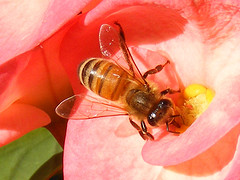What Are the Medical Uses for Honey?
Today is about Taking Care of Yourself
Photo by touterse
I like to use natural substances for healing as much as possible. However, I need proof that they work–particularly when they are expensive. Honey is a natural remedy and has been touted as good for treating lots of ailments. I first thought of its medicinal use after reading about a study that reported on honey and its effectiveness in treating night time cough in children.
After looking more into honey’s healing properties, I found there was lots of evidence showing that honey has good antibacterial qualities, and can be used to help heal wounds and burns. It has even been reported to be effective against staph aureus which causes a lot of wound infections, including the antibiotic resistant strain of staph called MRSA (methicillin resistant staph aureus).
Apparently, honey works to help heal wounds because it provides high concentrations of hydrogen peroxide, killing bacteria. The high sugar content (scientifically known as high osmolarity for you chemistry buffs) also kills bacteria. So the healing properties of honey are well described and well known.
But what are the drawbacks?
There is lots of variation in the strength of the healing properties of honey, and it depends a lot on what were the floral sources for the honey. Whatever source you use, it would be wise to make sure it is organic and does not contain pesticides or other contaminants. One type of honey that is reported to be created for medicinal use is Manuka honey from New Zealand. While the Manuka people insist nothing else will do, I am not clear on why it is so much better than a good organic honey. Many of the studies I saw used this honey, while others did not specify that it was Manuka.
I also have concerns because I’ve recently seen news stories about CCD, or colony collapse disorder, which is a condition where the worker bees in a colony suddenly disappear. The cause of this is not known, but the experts think it may be due to a combination of viral infections in beehives, exposure to toxins, or some immune problems with the bees. Since CCD has now been observed in Europe, North America and Taiwan, it would be important to make sure that any honey you use (even for your tea) does not come from a hive with CCD until the experts know the cause and risks to people.
So the bottom line is honey seems to work well not only for coughs, but for healing wounds and skin infections. It may provide alternative or supplemental treatment to antibiotics, and reduce our need for them (which contributes to antibiotic resistance). It is also effective against MRSA, a type of bacteria that is becoming harder to treat with current antibiotics. If you are going to use it, make sure it is free of impurities and pesticides, so invest in organic honey.
Anne
You have provide a great summary of things that honey can be used for. And for many of them, people should make use of what honey they have to hand, although the more natural (less processed) it is the better. If you have a cough or cold, use some of whatever honey you have in your cupboard already.
With regard to your question about manuka honey versus a good organic honey, the first important point to make is that not all manuka honey is the same. It naturally occurs in different potency levels. Much of it is simple manuka flavoured honey, and would be no different to a good organic honey. However some of it (and only some) has been proven to contain extra antibacterial properties, in addition the the hydrogen peroxide that comes from all honeys. The additional antibacterial property is more stable, and continues to work when mixed with wound fluids etc. There is a trademarked term, ‘UMF’ (Unique Manuka Factor) that can be found on the labels of that manuka honey which contains the additional antibacterial properties, along with a potency rating, eg a UMF 20+. You can find some examples of a recognised UMF manuka honey here.
One of the other drawbacks of honey – is it is sticky! If using for a wound or burn, generally you will want to place a dressing (as non-absorbent as possible) over top, simply to prevent sticky contact with clothing, furniture etc.
New Zealand Honey Shop
March 29, 2008
Thank you, Ann. Bt, a biomanufactured pesticide is killing. It paralyzes the gut. It is also harmful to humans and causes muscle and brain wasting. The toxic protein cannot be encapsulated by the machrophage. It is used in 80% of the world on crops, trees etc to kill bugs. Monsanto has added other vectors with it to make it more lethal. Fight this wherever you can until the information gets to the proper sources. Read “Silent Spring” about pesticides. Rachel Carson, the author, stopped DDT. We must stop this too. Save the Honey Bees, save the planet’s creatures and save the children. WE CAN DO IT!
Pamela Flavin-Dillon
October 12, 2008
ANY NEW INFORMATION ABOUT NEWER USES OF HONEY
NISOT
December 19, 2008
NICE BUT IT WILL BE BETTER TO INCLUDE ITS PHARMACOLOGICAL ACTION WITH ITS ACTIVE CONSTITUENT
KISHOR
July 15, 2009
Very educative & interesting.
Zakiyya
July 26, 2010
i have been trying to know what honey is good for.
shina
August 5, 2010
Honey is good for d eye,how can someone use it to treat it
Ageje taiwo
November 25, 2010
that was good i didnt know that honey can heal burns
monicah wanjiru
April 20, 2011
I know for a fact that honey has most vitimans but is it helpful for arterie disorders?
Keno Mc.Intosh
June 6, 2011